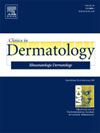粘膜黑色素瘤:从病理学家的角度回顾。
IF 2.3
4区 医学
Q2 DERMATOLOGY
引用次数: 0
摘要
粘膜黑色素瘤是一种罕见的恶性肿瘤,产生于人体粘膜内表面的上皮细胞。与皮肤黑色素瘤不同,我们目前对粘膜黑色素瘤的了解十分有限。粘膜黑色素瘤的基因改变与皮肤黑色素瘤截然不同,但其致病和促发因素尚不清楚。这些黑色素瘤由于位置隐蔽,通常在晚期才被诊断出来,因此预后较差。目前只有鼻窦和结膜黑色素瘤有专门的粘膜黑色素瘤分期系统。因此,对粘膜黑色素瘤患者,尤其是肛门部位的粘膜黑色素瘤患者进行风险分层具有挑战性。最近的研究表明,对 AJCC 第 8 版皮肤黑色素瘤分期系统稍加修改,就能相当稳妥地对患者进行分组;不过,所提出的 T 分类系统还有待在更大的群体中进行验证。我们总结了粘膜黑色素瘤常见亚型的人口统计学、临床、组织病理学和分子特征,并强调了这一领域的突出需求。本文章由计算机程序翻译,如有差异,请以英文原文为准。
Mucosal melanoma: Review from a pathologist point of view
Mucosal melanomas (MuM) are rare malignant tumors arising from the epithelia lining the inner mucosal surfaces of the body. Unlike cutaneous melanoma, understanding of MuM is limited among pathologists and clinicians alike, primarily due to rarity of these tumors. MuM are characterized by genetic alterations quite distinct from cutaneous melanomas; however, their causative and promoting factors are unknown. These melanomas are characteristically diagnosed at a later stage due to their occult locations, leading to a worse prognosis. Dedicated staging systems for MuM exist only for sinonasal and conjunctival melanomas. Risk stratification of patients with MuM, particularly those arising from the anogenital area, is challenging. Recent studies have shown that minor modifications of the American Joint Committee on Cancer eighth edition cutaneous melanoma staging system can group patients fairly robustly; however, the proposed T-categorization systems have yet to be validated in larger cohorts. We summarize the demographic, clinical, histopathologic, and molecular features of common subtypes of MuM and highlight the outstanding needs in this field.
求助全文
通过发布文献求助,成功后即可免费获取论文全文。
去求助
来源期刊

Clinics in dermatology
医学-皮肤病学
CiteScore
4.60
自引率
7.40%
发文量
106
审稿时长
3 days
期刊介绍:
Clinics in Dermatology brings you the most practical and comprehensive information on the treatment and care of skin disorders. Each issue features a Guest Editor and is devoted to a single timely topic relating to clinical dermatology.
Clinics in Dermatology provides information that is...
• Clinically oriented -- from evaluation to treatment, Clinics in Dermatology covers what is most relevant to you in your practice.
• Authoritative -- world-renowned experts in the field assure the high-quality and currency of each issue by reporting on their areas of expertise.
• Well-illustrated -- each issue is complete with photos, drawings and diagrams to illustrate points and demonstrate techniques.
 求助内容:
求助内容: 应助结果提醒方式:
应助结果提醒方式:


